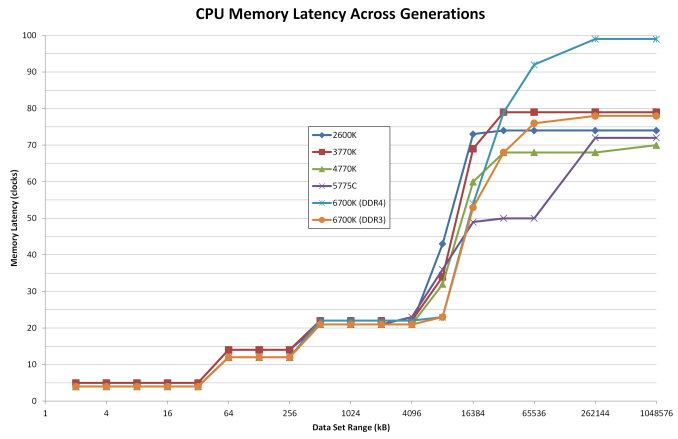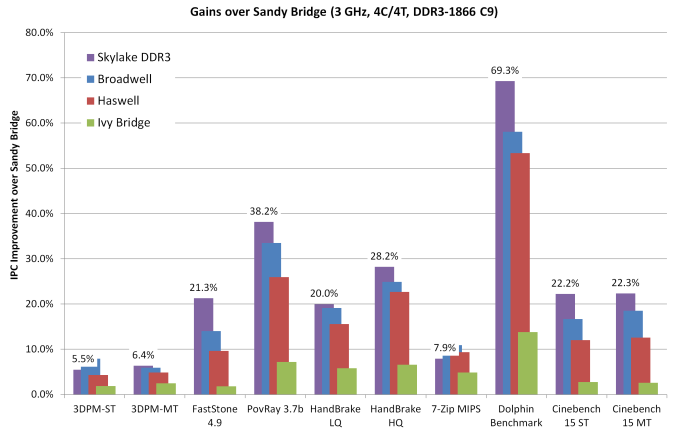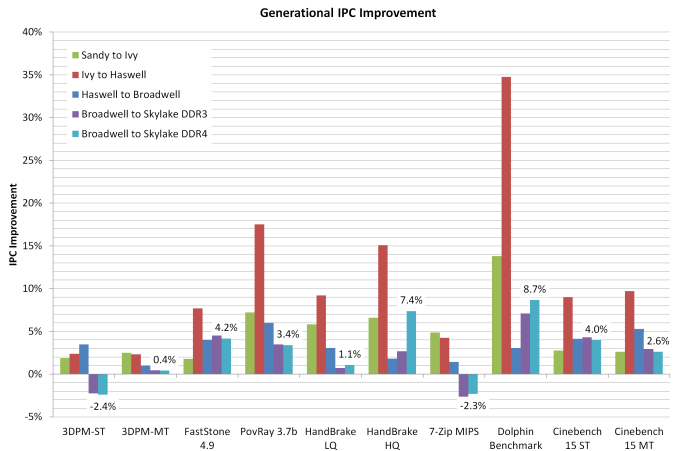The Intel 6th Gen Skylake Review: Core i7-6700K and i5-6600K Tested
by Ian Cutress on August 5, 2015 8:00 AM ESTComparing IPC on Skylake: Memory Latency and CPU Benchmarks
The following explanation of IPC has been previously used in our Broadwell review.
Being able to do more with less, in the processor space, allows both the task to be completed quicker and often for less power. While the concept of having devices with multiple cores has allowed many programs to run at once, purely parallel compute such as graphics and most things to run faster, we are all still limited by the fact that a lot of software is still relying on one line of code after another. This is referred to as the serial part of the software, and is the basis for many early programming classes – getting the software to compile and complete is more important than speed. But the truth is that having a few fast cores helps more than several thousand super slow cores. This is where IPC comes in to play.
The principles behind extracting IPC are quite complex as one might imagine. Ideally every instruction a CPU gets should be read, executed and finished in one cycle, however that is never the case. The processor has to take the instruction, decode the instruction, gather the data (depends on where the data is), perform work on the data, then decide what to do with the result. Moving has never been more complicated, and the ability for a processor to hide latency, pre-prepare data by predicting future events or keeping hold of previous events for potential future use is all part of the plan. All the meanwhile there is an external focus on making sure power consumption is low and the frequency of the processor can scale depending on what the target device actually is.
For the most part, Intel has successfully increased IPC every generation of processor. In most cases, 5-10% with a node change and 5-25% with an architecture change with the most recent large jumps being with the Core architecture and the Sandy Bridge architectures, ushering in new waves of super-fast computational power. As Broadwell to Skylake is an architecture change with what should be large updates, we should expect some good gains.
| Intel Desktop Processor Cache Comparison | |||||
| L1-D | L1-I | L2 | L3 | L4 | |
| Sandy Bridge i7 | 4 x 32 KB | 4 x 32 KB | 4 x 256 KB | 8 MB | |
| Ivy Bridge i7 | 4 x 32 KB | 4 x 32 KB | 4 x 256 KB | 8 MB | |
| Haswell i7 | 4 x 32 KB | 4 x 32 KB | 4 x 256 KB | 8 MB | |
| Broadwell i7 (Desktop / Iris Pro 6200) |
4 x 32 KB | 4 x 32 KB | 4 x 256 KB | 6 MB | 128 MB eDRAM |
| Skylake i7 | 4 x 32 KB | 4 x 32 KB | 4 x 256 KB | 8 MB | |
For this test we took Intel’s most recent high-end i7 processors from the last five generations and set them to 3.0 GHz and with HyperThreading disabled. As each platform uses DDR3, we set the memory across each to DDR3-1866 with a CAS latency of 9. For Skylake we also run at DDR4-2133 C15 as a default speed. From a pure cache standpoint, here is how each of the processors performed:
If we ignore Broadwell and its eDRAM, the purple line, especially from 16MB to 128MB, both of the lines for Skylake stay at the low latencies until 4MB. Between 4MB and 8MB, the cache latency still seems to be substantially lower than that of the previous generations.
Normally in this test, despite all of the CPUs having 8MB of L3 cache, the 8MB test has to spill out to main memory because some of the cache is already filled. If you have a more efficient caching and pre-fetch algorithm here, then the latency ‘at 8MB’ will be lower. So an update for Skylake, as shown in both the DDR4 and DDR3 results, is that the L3 caching algorithms or hardware resources have been upgraded.
At this point I would also compare the DDR3 to DDR4 results on Skylake above 16MB. It seems that the latency in this region is a lot higher than the others, showing nearly 100 clocks as we move up to 1GB. But it is worth remembering that these tests are against a memory clock of 2133 MHz, whereas the others are at 1866 MHz. As a result, the two lines are more or less equal in terms of absolute time, as we would expect.
Here are the generational CPU results at 3.0 GHz:
Dolphin Benchmark: link
Many emulators are often bound by single thread CPU performance, and general reports tended to suggest that Haswell provided a significant boost to emulator performance. This benchmark runs a Wii program that raytraces a complex 3D scene inside the Dolphin Wii emulator. Performance on this benchmark is a good proxy of the speed of Dolphin CPU emulation, which is an intensive single core task using most aspects of a CPU. Results are given in minutes, where the Wii itself scores 17.53 minutes.

Cinebench R15
Cinebench is a benchmark based around Cinema 4D, and is fairly well known among enthusiasts for stressing the CPU for a provided workload. Results are given as a score, where higher is better.


Point Calculations – 3D Movement Algorithm Test: link
3DPM is a self-penned benchmark, taking basic 3D movement algorithms used in Brownian Motion simulations and testing them for speed. High floating point performance, MHz and IPC wins in the single thread version, whereas the multithread version has to handle the threads and loves more cores. For a brief explanation of the platform agnostic coding behind this benchmark, see my forum post here.


Compression – WinRAR 5.0.1: link
Our WinRAR test from 2013 is updated to the latest version of WinRAR at the start of 2014. We compress a set of 2867 files across 320 folders totaling 1.52 GB in size – 95% of these files are small typical website files, and the rest (90% of the size) are small 30 second 720p videos.

Image Manipulation – FastStone Image Viewer 4.9: link
Similarly to WinRAR, the FastStone test us updated for 2014 to the latest version. FastStone is the program I use to perform quick or bulk actions on images, such as resizing, adjusting for color and cropping. In our test we take a series of 170 images in various sizes and formats and convert them all into 640x480 .gif files, maintaining the aspect ratio. FastStone does not use multithreading for this test, and thus single threaded performance is often the winner.

Video Conversion – Handbrake v0.9.9: link
Handbrake is a media conversion tool that was initially designed to help DVD ISOs and Video CDs into more common video formats. The principle today is still the same, primarily as an output for H.264 + AAC/MP3 audio within an MKV container. In our test we use the same videos as in the Xilisoft test, and results are given in frames per second.


Rendering – PovRay 3.7: link
The Persistence of Vision RayTracer, or PovRay, is a freeware package for as the name suggests, ray tracing. It is a pure renderer, rather than modeling software, but the latest beta version contains a handy benchmark for stressing all processing threads on a platform. We have been using this test in motherboard reviews to test memory stability at various CPU speeds to good effect – if it passes the test, the IMC in the CPU is stable for a given CPU speed. As a CPU test, it runs for approximately 2-3 minutes on high end platforms.

Synthetic – 7-Zip 9.2: link
As an open source compression tool, 7-Zip is a popular tool for making sets of files easier to handle and transfer. The software offers up its own benchmark, to which we report the result.

Overall: CPU IPC
Removing WinRAR as a benchmark because it gets boosted by the eDRAM in Broadwell, we get an interesting look at how each generation has evolved over time. Taking Sandy Bridge (i7-2600K) as the base, we have the following:
From a pure upgrade perspective, the IPC gain here for Skylake does not look great. In fact in two benchmarks the IPC seems to have decreased – 3DPM in single thread mode and 7-ZIP. What makes 3DPM interesting is that the multithread version still has some improvement at least, if only minor. This difference between MT and ST is more nuanced than first appearances suggest. Throughout the testing, it was noticeable that multithreaded results seem to (on average) get a better kick out of the IPC gain than single threaded. If this is true, it would suggest that Intel has somehow improved its thread scheduler or offered new internal hardware to deal with thread management. We’ll probably find out more at IDF later in the year.
If we adjust this graph to show generation to generation improvement and include the DDR4 results:
This graph shows that:
Sandy Bridge to Ivy Bridge: Average ~5.8% Up
Ivy Bridge to Haswell: Average ~11.2% Up
Haswell to Broadwell: Average ~3.3% Up
Broadwell to Skylake (DDR3): Average ~2.4% Up
Broadwell to Skylake (DDR4): Average ~2.7% Up
Oh dear. Typically with an architecture update we see a bigger increase in performance than 2.7% IPC. Looking at matters purely from this perspective, Skylake does not come out well. These results suggest that Skylake is merely another minor upgrade in the performance metrics, and that a clock for clock result compared to Broadwell is not favorable. However, consider that very few people actually invested in Broadwell. If anything, Haswell was the last major mainstream processor generation that people actually purchased, which means that:
Haswell to Skylake (DDR3): Average ~5.7% Up.
This is more of a bearable increase, and it takes advantage of the fact that Broadwell on the desktop was a niche focused launch. The other results in the review will be interesting to see.













477 Comments
View All Comments
medi03 - Thursday, August 6, 2015 - link
Yeah. Blaming Intel that HP didn't want to use FASTER AMD CPUs FOR FREE, fearing Intel's illegal revenge is just nuts.AMD Athlon 64's beat Intel in all regards, they were faster, cheaper and less power hungry. Yet Intel was selling several times more Prescotts,
Not being able to profit even in a situation when you have superior product (despite much modest R&D budget), yeah, why blame intel.
MrBungle123 - Sunday, August 9, 2015 - link
In the Athlon 64 days, yes, AMD had a better product but the cold hard truth behind the curtain was that AMD didn't have the manufacturing capacity to supply everyone that Intel was feeding chips to.silverblue - Thursday, August 6, 2015 - link
A "tweaked 8-core Ph2"? Putting aside the fact that significant changes would've been required to the fetch and retire hardware (the integer units themselves were very capable but were underutilised), a better IMC and all the modern instruction sets that K10 didn't support, AMD had already developed its replacement. It probably would've buried them to have to shelve Bulldozer (twice, it turns out) and redevelop what was essentially a 12-year old micro-architecture.AMD were under pressure to deliver Bulldozer hence the cutting of corners and the decision to go with GF's poor 32nm process as they simply didn't have any alternative (plus I imagine they were promised far more than GF could deliver). Phenom II was not enough against Nehalem, let alone Sandy Bridge.
Blaming Intel doesn't help either as AMD couldn't exactly saturate the market with their products even when they were fabbing them themselves, however I think the huge drop in mainstream CPU prices when Core 2 was released along with the huge price paid for ATi did more damage than any bribing of retailers and systems manufacturers.
nikaldro - Wednesday, August 5, 2015 - link
40% over excavator, with 8 cores, good clockspeeds and good pricing doesn't sound that bad. I'll wait till Zen comes out, then decide.Spoelie - Thursday, August 6, 2015 - link
IPC difference between piledriver and skylake amounts to 80%... Lets hope excavator's IPC is better than anticipated and 40% is sandbagging it a bit.Given AMD's track record of overpromising and underdelivering, I'm afraid Zen will massively disappoint.
Asomething - Thursday, August 6, 2015 - link
Well it will only be behind by something like 15-25% if the difference between piledriver and skylake is 80% since piledriver to excavator is supposed to be a good 20% jump. If amd can manage to catchup in any meaningful way and make chips that can touch 5ghz then things might turn out ok.mapesdhs - Thursday, August 6, 2015 - link
Catchup will not be good enough. They need to be usefully competitive to pull people away from Intel into a platform switch, especially business, who have to think about this sort of thing for the long haul, and AMD's track record has been pretty woeful in this regard. I hope they can bring it to the table with Zen, but I'll believe it when I see it. Highly unlikely Intel isn't planning to either splat its prices or shove up performance, etc., if they need to when Zen comes out, especially for consumer CPUs. We know what's really possible based on how many cores, TDP, clock rates, etc. are used for the XEONs, but that potential just hasn't been put into a consumer chip yet.Remember, Intel could have released an 8-core for X79, but they didn't because there was no need; indeed the 3930K *is* an 8-core, just with 2 cores disabled (read the reviews). Ever since then, again and again, Intel has held back what it's perfectly capable of producing if it wanted to. The low clock of the 5960X is yet another example, it could easily be much higher.
MapRef41N93W - Friday, August 7, 2015 - link
You're assuming it's going to be a flat 40% over Excavator and not a best case scenario 40% (like every single AMD future performance projection always is...). It's more than likely a flat 20% IPC increase which puts it even behind Nehalem IPC wise.Top off the fact that it's AMD's first FinFET part (look at the penalty Intel paid in clockspeed with the transition to FinFET with IB/HW) and a transition to a new scalable uARCH (again look at the clockspeed hit Intel took when going from Netburst to scalable core arch, very similar to what AMD is doing now actually) and I can see Zen parts clocking horribly on top of that. Being on a Samsung node that is designed with low power in mind won't help their case either.
You may get an 8 core Zen part for $300-$400 but it probably won't clock worth a damn and end up at 3.5-4GHz on average. So it would be a much worse choice than a 5820k for most people.
mapesdhs - Wednesday, August 12, 2015 - link
Btw, I wasn't assuming anything about Zen, I really haven't a clue how it'll compare to Intel's offerings of the day. I hope it's good, but with all that's happened before, I hope for the best but expect the worst, though I'd like to be wrong.Azix - Friday, August 21, 2015 - link
You guys are being pretty negative on AMD. AMD tried to do an 8core chip on 32nm, maybe that was their mistake. The market wasn't even ready considering how long that way and where we are now. I do think intel got them pretty badly with their cheatingThe next processors are on a much better process. Based on the process alone we would expect a significant bit more performance than some seem willing to allow. Not to mention the original architecture was designed on a 32nm process. It's no surprise it would fall that far behind intel who is currently on 14nm. As time progresses though, those process jumps will take intel longer and longer. AMD will be much closer. Next year will be the first these two are on the same process (similar anyway). in a long while and it will last till at least 2017. AMD should be able to pick up some CPU sales next year and hopefully return to profitability. Intel also enjoys ddr4 support.
Stop pushing old 32nm architectures and crappy motherboards.